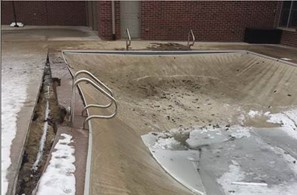A beautiful in-ground pool can create hours of fun with family and friends. It’s critically important, however, to properly winterize the pool to avoid damage and costly repairs, and even to prevent a claim against your homeowner’s insurance.
Protective automatic covers have become increasingly popular. They offer great benefits because they’re easy to open and close on an automated track, they keep the water heated, and they prevent debris, animals, or children from getting into the pool. But if the pool isn’t properly winterized, the weight of water, ice, or snow on the cover can cause costly damage.
Once the temperature consistently drops to 65 degrees and below, it’s time to winterize the pool for protection. Here are some steps you should follow.
1. The pool should be thoroughly cleaned, including skimming all debris, vacuuming, brushing the bottom and all sides, and balancing all chemicals.
2. Clean, back wash, and drain the filter and pump of all debris and water and blow out all water lines. This will help you avoid any damage to these costly pieces of equipment that can be caused by freezing.
3. Drain the water three to six inches below the skimmer and jets so no water can enter and cause freezing damage. Finally, add winterizing chemicals to the water as this will deter freezing and stop algae growth during those months the pool is covered and not in use. You may wish to consider hiring a local pool maintenance company to do the full winterizing process to best protect your investment.
The water level of your pool is the most important fact to consider when protecting it during the cold-weather months. Keeping water in a pool over the winter helps keep the liner clean, thus avoiding damage from debris. It also evens the weight pressure on the walls and prevents them from bowing or collapsing during expansion/contraction. When an automatic cover is in place for extended periods of time, it’s critical to make sure the water level remains adequate. A slow leak or too much evaporation that decreases the water level can cause collapse as the season continues.
Water and ice that accumulates on top of the cover can be thawed and pumped off with special equipment to avoid that weight on the cover, as well as the drowning hazard it can create. Because it’s more frequent, however, snow can be more difficult to remove. Long-handled brooms made of the proper material or a hand-held blower can be used to sweep or blow lighter snow off the cover. It’s important to do this after every snowfall because it can build up and become difficult to remove. There are special waterproof heating cables and pool salt (NOT rock salt used on driveways or sidewalks) that can help melt the snow so it can then be pumped off. Most automatic covers have an approximate 400-pound weight limit but just one cubic foot of snow weighs 20 pounds so the weight on an entire pool cover can add up quickly. If large amounts of water, snow, or ice aren’t removed, it can cause the cover to sag inward. Depending on the water level, the cover can collapse with such pressure that it pulls the entire side of pool and tracking system away. This can cause $50,000 or more in repairs, and in many areas, pool contractors who can service this type of damage are limited.

Damaged pool
In the Midwest, where Mother Nature sends heavier amounts of rain, ice, and snow, it’s highly recommended to retract an automatic cover and purchase a winter safety cover with built-in spring tension and drainage features to better handle the fluctuating weight in the off-season.
Properly winterizing your pool will help you avoid costly damage and lengthy repairs that can delay your fun next swimming season. Take the time to work with a local pool company to ensure it’s winterized properly, keeping your pool beautiful and functional for many years to come.
